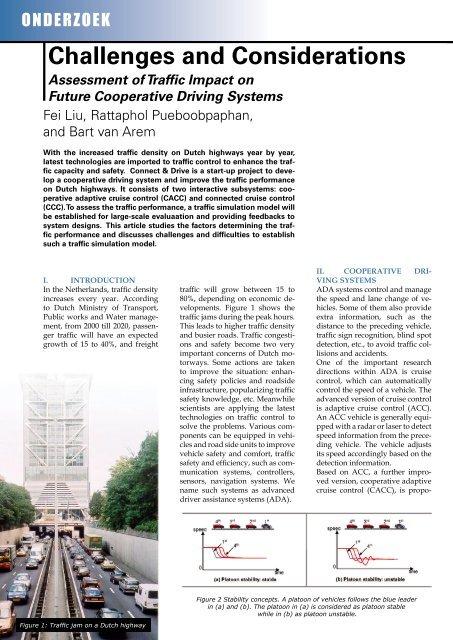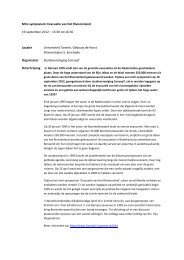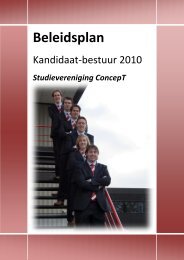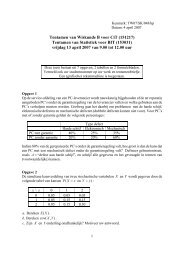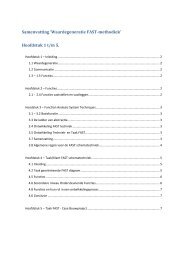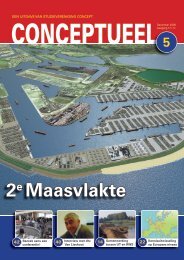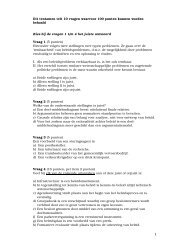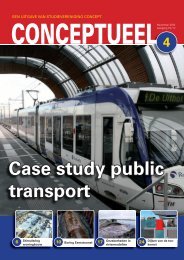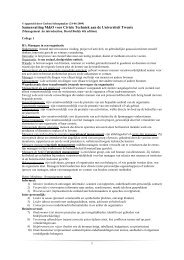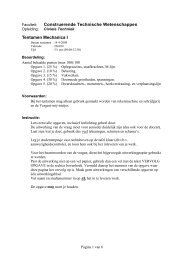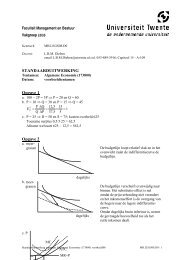Bijzondere bouwput - Studievereniging ConcepT - Universiteit Twente
Bijzondere bouwput - Studievereniging ConcepT - Universiteit Twente
Bijzondere bouwput - Studievereniging ConcepT - Universiteit Twente
You also want an ePaper? Increase the reach of your titles
YUMPU automatically turns print PDFs into web optimized ePapers that Google loves.
ONDERZOEK<br />
Challenges and Considerations<br />
Assessment of Traffic Impact on<br />
Future Cooperative Driving Systems<br />
Fei Liu, Rattaphol Pueboobpaphan,<br />
and Bart van Arem<br />
With the increased traffic density on Dutch highways year by year,<br />
latest technologies are imported to traffic control to enhance the traffic<br />
capacity and safety. Connect & Drive is a start-up project to develop<br />
a cooperative driving system and improve the traffic performance<br />
on Dutch highways. It consists of two interactive subsystems: cooperative<br />
adaptive cruise control (CACC) and connected cruise control<br />
(CCC). To assess the traffic performance, a traffic simulation model will<br />
be established for large-scale evaluaation and providing feedbacks to<br />
system designs. This article studies the factors determining the traffic<br />
performance and discusses challenges and difficulties to establish<br />
such a traffic simulation model.<br />
I. INTRODUCTION<br />
In the Netherlands, traffic density<br />
increases every year. According<br />
to Dutch Ministry of Transport,<br />
Public works and Water management,<br />
from 2000 till 2020, passenger<br />
traffic will have an expected<br />
growth of 15 to 40%, and freight<br />
traffic will grow between 15 to<br />
80%, depending on economic developments.<br />
Figure 1 shows the<br />
traffic jams during the peak hours.<br />
This leads to higher traffic density<br />
and busier roads. Traffic congestions<br />
and safety become two very<br />
important concerns of Dutch motorways.<br />
Some actions are taken<br />
to improve the situation: enhancing<br />
safety policies and roadside<br />
infrastructure, popularizing traffic<br />
safety knowledge, etc. Meanwhile<br />
scientists are applying the latest<br />
technologies on traffic control to<br />
solve the problems. Various components<br />
can be equipped in vehicles<br />
and road side units to improve<br />
vehicle safety and comfort, traffic<br />
safety and efficiency, such as communication<br />
systems, controllers,<br />
sensors, navigation systems. We<br />
name such systems as advanced<br />
driver assistance systems (ADA).<br />
II. COOPERATIVE DRI-<br />
VING SYSTEMS<br />
ADA systems control and manage<br />
the speed and lane change of vehicles.<br />
Some of them also provide<br />
extra information, such as the<br />
distance to the preceding vehicle,<br />
traffic sign recognition, blind spot<br />
detection, etc., to avoid traffic collisions<br />
and accidents.<br />
One of the important research<br />
directions within ADA is cruise<br />
control, which can automatically<br />
control the speed of a vehicle. The<br />
advanced version of cruise control<br />
is adaptive cruise control (ACC).<br />
An ACC vehicle is generally equipped<br />
with a radar or laser to detect<br />
speed information from the preceding<br />
vehicle. The vehicle adjusts<br />
its speed accordingly based on the<br />
detection information.<br />
Based on ACC, a further improved<br />
version, cooperative adaptive<br />
cruise control (CACC), is propo-<br />
10 - <strong>ConcepT</strong>ueel okt. 2009<br />
Figure 1: Traffic jam on a Dutch highway<br />
Figure 2 Stability concepts. A platoon of vehicles follows the blue leader<br />
in (a) and (b). The platoon in (a) is considered as platoon stable<br />
while in (b) as platoon unstable.


